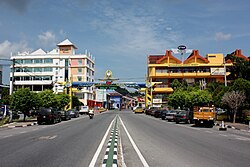Negeri Sembilan, one of the 13 states that constitutes Malaysia, lies on the western coast of Peninsular Malaysia, just south of Kuala Lumpur and borders Selangor on the north, Pahang in the east, and Malacca and Johor to the south.
The name is believed to derive from the nine districts or negara (now known as luak) settled by the Minangkabau, a people originally from West Sumatra (in present-day Indonesia). Minangkabau features are still visible today in traditional architecture and the dialect of Malay spoken.
Unlike the hereditary monarchs of the other royal Malay states, the ruler of Negeri Sembilan is known as Yang di-Pertuan Besar instead of Sultan. The election of the Ruler is also unique. He is selected by the council of Undangs who lead the four biggest districts of Sungai Ujong, Jelebu, Johol, and Rembau, making it one of the more democratic monarchies.
The capital of Negeri Sembilan is Seremban. The royal capital is Seri Menanti in the district of Kuala Pilah. Other important towns are Port Dickson and Nilai.
The Arabic honorific title of the state is Darul Khusus.
The Minangkabaus from Sumatra settled in Negeri Sembilan in the 15th century under the protection of the Malacca Sultanate, and later under the protection of its successor, the Sultanate of Johor. As Johor weakened in the 18th century, attacks by the Bugis forced the Minangkabaus to seek protection from their homeland. The Minangkabau ruler, Sultan Abdul Jalil, obliged by sending his near relative, Raja Melewar. When he arrived, he found that another royal, Raja Khatib had already established himself as ruler. He declared war against Raja Khatib and became the ruler of Negeri Sembilan. The Sultan of Johor confirmed his position by granting the title Yang di-Pertuan Besar Negeri Sembilan (He Who is Highest Lord of the Nine States) in 1773. After Raja Melewar's death, a series of disputes arose over the succession. For a considerable period, the local nobles applied to the Minangkabau ruler in Sumatra for a ruler. However, competing interests supported different candidates, often resulting in instability and civil war.
In 1873, the British intervened militarily in a civil war in Sungai Ujong to preserve British economic interests, and placed the country under the control of a British Resident. Jelebu followed in 1886, and the remaining states in 1895. In 1897, when the Federated Malay States (FMS) was established, Sungai Ujong and Jelebu were reunited to the confederation of small states and the whole, under the old name of the Negeri Sembilan, was placed under a single Resident and became a member of the FMS.
The number of states within Negeri Sembilan has fluctuated over the years, the federation now consists of six states and a number of sub-states under their suzerainty. The former state of Naning was annexed to Malacca, Kelang to Selangor, and Segamat to Johor.
Negeri Sembilan endured Japanese occupation in World War II between 1941 and 1945, and joined the Federation of Malaya in 1948, and became a state of Malaysia in 1963.
